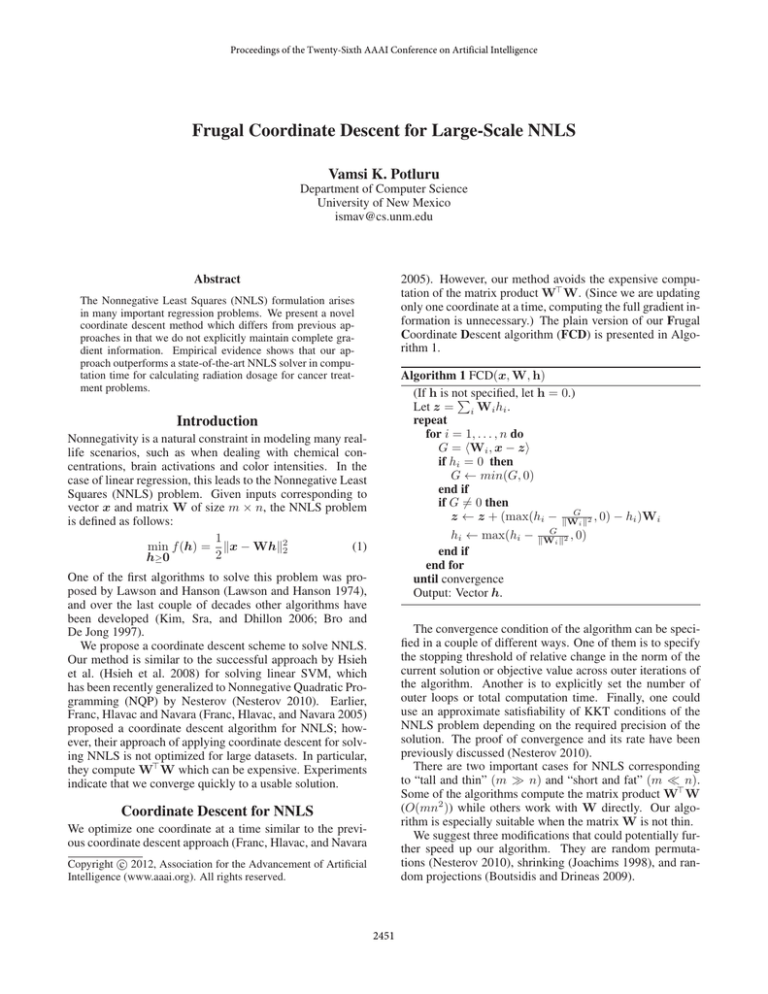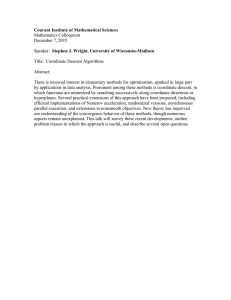
Proceedings of the Twenty-Sixth AAAI Conference on Artificial Intelligence
Frugal Coordinate Descent for Large-Scale NNLS
Vamsi K. Potluru
Department of Computer Science
University of New Mexico
ismav@cs.unm.edu
Abstract
2005). However, our method avoids the expensive computation of the matrix product W> W. (Since we are updating
only one coordinate at a time, computing the full gradient information is unnecessary.) The plain version of our Frugal
Coordinate Descent algorithm (FCD) is presented in Algorithm 1.
The Nonnegative Least Squares (NNLS) formulation arises
in many important regression problems. We present a novel
coordinate descent method which differs from previous approaches in that we do not explicitly maintain complete gradient information. Empirical evidence shows that our approach outperforms a state-of-the-art NNLS solver in computation time for calculating radiation dosage for cancer treatment problems.
Algorithm 1 FCD(x, W, h)
(If h is not
Pspecified, let h = 0.)
Let z = i Wi hi .
repeat
for i = 1, . . . , n do
G = hWi , x − zi
if hi = 0 then
G ← min(G, 0)
end if
if G =
6 0 then
z ← z + (max(hi − kWGi k2 , 0) − hi )Wi
hi ← max(hi − kWGi k2 , 0)
end if
end for
until convergence
Output: Vector h.
Introduction
Nonnegativity is a natural constraint in modeling many reallife scenarios, such as when dealing with chemical concentrations, brain activations and color intensities. In the
case of linear regression, this leads to the Nonnegative Least
Squares (NNLS) problem. Given inputs corresponding to
vector x and matrix W of size m × n, the NNLS problem
is defined as follows:
1
min f (h) = kx − Whk22
(1)
2
h≥0
One of the first algorithms to solve this problem was proposed by Lawson and Hanson (Lawson and Hanson 1974),
and over the last couple of decades other algorithms have
been developed (Kim, Sra, and Dhillon 2006; Bro and
De Jong 1997).
We propose a coordinate descent scheme to solve NNLS.
Our method is similar to the successful approach by Hsieh
et al. (Hsieh et al. 2008) for solving linear SVM, which
has been recently generalized to Nonnegative Quadratic Programming (NQP) by Nesterov (Nesterov 2010). Earlier,
Franc, Hlavac and Navara (Franc, Hlavac, and Navara 2005)
proposed a coordinate descent algorithm for NNLS; however, their approach of applying coordinate descent for solving NNLS is not optimized for large datasets. In particular,
they compute W> W which can be expensive. Experiments
indicate that we converge quickly to a usable solution.
The convergence condition of the algorithm can be specified in a couple of different ways. One of them is to specify
the stopping threshold of relative change in the norm of the
current solution or objective value across outer iterations of
the algorithm. Another is to explicitly set the number of
outer loops or total computation time. Finally, one could
use an approximate satisfiability of KKT conditions of the
NNLS problem depending on the required precision of the
solution. The proof of convergence and its rate have been
previously discussed (Nesterov 2010).
There are two important cases for NNLS corresponding
to “tall and thin” (m n) and “short and fat” (m n).
Some of the algorithms compute the matrix product W> W
(O(mn2 )) while others work with W directly. Our algorithm is especially suitable when the matrix W is not thin.
We suggest three modifications that could potentially further speed up our algorithm. They are random permutations (Nesterov 2010), shrinking (Joachims 1998), and random projections (Boutsidis and Drineas 2009).
Coordinate Descent for NNLS
We optimize one coordinate at a time similar to the previous coordinate descent approach (Franc, Hlavac, and Navara
c 2012, Association for the Advancement of Artificial
Copyright Intelligence (www.aaai.org). All rights reserved.
2451
Figure 2: Running times verses objective values for FCD
and PLB are shown for the real tumor dataset .
Figure 1: (Left) Mean running times for each problem size
where the elements of the matrix W and vector x are drawn
uniformly at random from [0, 1]. The running times for the
solvers should be taken with a grain of salt because of the
different stopping criterion used. (Right) Running times versus objective values for our (FCD) algorithm and the competing FNNLS and PLB algorithms on the phantom tumor
dataset.
Conclusions and Future Work
We have presented a coordinate-descent algorithm to solve
the NNLS problem. The new algorithm is simple to implement and its rate of convergence is at least linear. We have
shown its application to two examples of dose calculation
in radiation therapy. Our algorithm has the potential to be
parallelized (Bradley et al. 2011).
Acknowledgement
Experiments
The author acknowledges the support from NIBIB grants 1
R01 EB 000840 and 1 R01 EB 005846, and also the fruitful discussions with Sergey Plis, Thomas Hayes, Vince Calhoun, Shuang Luan and Barak Pearlmutter.
In this section, we compare our algorithm with two NNLS
solvers called PLB (Kim, Sra, and Dhillon 2006) and
FNNLS (Bro and De Jong 1997). First, we applied our algorithm FCD and the competing solvers on various synthetic
datasets ranging in size from 300×200 to 9000×6000. Next,
we consider a large dataset obtained from a phantom commonly used for benchmarking radiosurgery treatment planning systems by Luan et al. (Luan et al. 2009). The size of
the input matrix W is 42875 × 20268. Also, we consider a
skull base tumor case that was treated with carbon ion therapy which was obtained from the German Cancer Research
Center (DKFZ), of Heidelberg, Germany. The size of the
input matrix W is 227920 × 6505. Clinically, each column
of the matrix W represents the radiation energy distribution
deposited by a “shot” of radiation in Gamma Knife radiosurgery. The matrix x represents the ideal radiation energy
deposition as prescribed by the physician. The sought variable h denotes the beam-on time need for each shot (i.e., a
column of W ) to create a radiation dose distribution that is
as close to the ideal as possible. The results of running times
for the synthetic and the phantom datasets are shown in Figure 1. Similarly, the running times versus objective values
for the real tumor dataset is shown in Figure 2.
Our algorithm was implemented in MATLAB (http://
www.mathworks.com) similar to the PLB algorithm. We
used the default settings for the competing algorithm as
given by the implementation. All of our experiments were
run on a 3.2 Ghz Intel machine with 24GB of RAM and the
number of threads set to one.
We note that our algorithm converges rapidly to within
1% of final value very fast. This accuracy is good enough in
practice for radiation dosage calculations.
References
Boutsidis, C., and Drineas, P. 2009. Random projections for the
nonnegative least-squares problem. Linear Algebra and its Applications 431(5-7):760–771.
Bradley, J. K.; Kyrola, A.; Bickson, D.; and Guestrin, C. 2011.
Parallel coordinate descent for l1-regularized loss minimization. In
ICML, 321–328.
Bro, R., and De Jong, S. 1997. A fast non-negativity-constrained
least squares algorithm. Journal of Chemometrics 11(5):393–401.
Franc, V.; Hlavac, V.; and Navara, M. 2005. Sequential coordinatewise algorithm for the non-negative least squares problem. In Computer Analysis of Images and Patterns, 407.
Hsieh, C.-J.; Chang, K.-W.; Lin, C.-J.; Keerthi, S. S.; and Sundararajan, S. 2008. A dual coordinate descent method for largescale linear SVM. In Proceedings of the 25th international conference on Machine learning, ICML ’08, 408–415. New York, NY,
USA: ACM.
Joachims, T. 1998. Making large-scale SVM learning practical.
LS8-Report 24, Universität Dortmund, LS VIII-Report.
Kim, D.; Sra, S.; and Dhillon, I. 2006. A new projected quasinewton approach for the nonnegative least squares problem. Citeseer.
Lawson, C., and Hanson, R. 1974. Solving least squares problems,
340 pp.
Luan, S.; Swanson, N.; Chen, Z.; and Ma, L. 2009. Dynamic gamma knife radiosurgery. Physics in Medicine and Biology
54:1579.
Nesterov, Y. 2010. Efficiency of coordinate descent methods on
huge-scale optimization problems. CORE Discussion Papers.
2452




